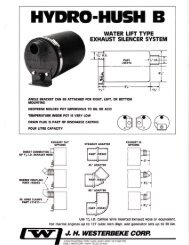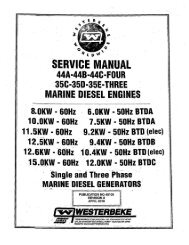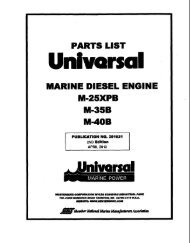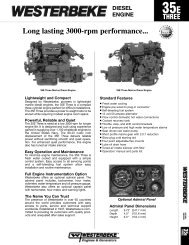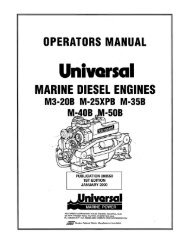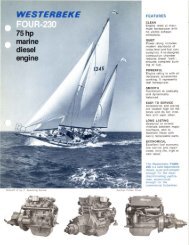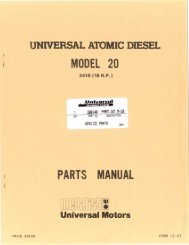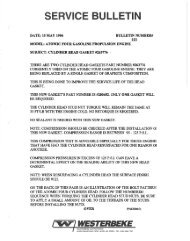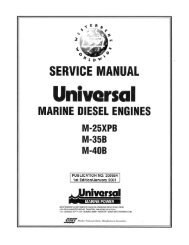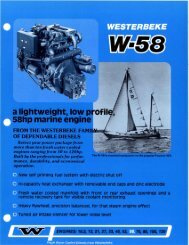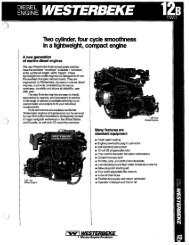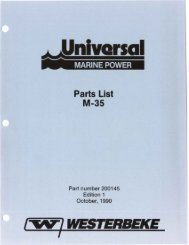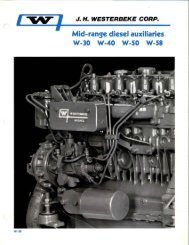OPERATORS MANUAL - Westerbeke
OPERATORS MANUAL - Westerbeke
OPERATORS MANUAL - Westerbeke
Create successful ePaper yourself
Turn your PDF publications into a flip-book with our unique Google optimized e-Paper software.
FROM<br />
TANK<br />
Refilling the Coolant<br />
After replacing the manifold drain plug, run thc engine at<br />
idle and slowly pour clean, premixed coolant into the manifold.<br />
NOTE: When a steady flow of coolant appears at the heat<br />
exchanger drain plug opening, close the drain plug and fill<br />
the system until the manifold remains full.<br />
Monitor the coolant in the manifold and add as needed. Fill<br />
the manifold to the filler neck and install the manifold pressure<br />
cap.<br />
Remove the cap on the coolant recovery tank and fill with<br />
coolant mix to halfway between LOW and MAX and replace<br />
the cap. Run the engine and observe the coolant expansion<br />
flow into the recovery tank.<br />
After checking for leaks, stop the engine and allow it to cool.<br />
Coolant should draw back into the cooling system as the<br />
engine cools down. Add coolant to the "recovery tank if<br />
needed. Clean up any spilled coolant.<br />
COOLANT RETRACTION<br />
TO COOLANT<br />
RECOVERY<br />
TANK<br />
tNSPECT AND CLEAN<br />
THE COOLANT RECOVERY<br />
TANK AND tTS CONNECTING<br />
HOSE EVERY 3 MONTHS<br />
ENGINE COOLING CIRCUIT<br />
j)---- MANtFOlD PRESSURE CAP<br />
COOLANT EXPANSION<br />
NOTE: Periodically check the condition of the manifold pressure<br />
cap. Ensure that the upper and lower rubber seals are in<br />
good condition and check that the vacuum valve opens alld<br />
closes tightly. Carry a spare cap.<br />
THERMOSTAT<br />
A thermostat, located near the manifold at the front of the<br />
engine, controls the coolant temperature, as it continuously<br />
flows through the closed cooling circuit. When the engine<br />
is first started the closed thermostat prevents coolant from<br />
flowing (some coolant is by-passed through a hole in the<br />
thennostat to prevent the exhaust manifold from overheating);<br />
as the engine wanns up the thermostat gradually opens.<br />
The thermostat is accessible and can be checked, cleaned, or<br />
replaced easily. Carry a spare thennostat and gasket.<br />
Replacing the Thermostat<br />
Remove the cap screws and disassemble the thermostat housing<br />
as shown. When installing the new thermostat and gasket<br />
apply a thin coat of sealant on both sides of the gasket before<br />
pressing it into place. Do not over-tighten the cap screws.<br />
Run the engine and check for normal temperatures and that<br />
there are no leaks at the thermostat housing.<br />
TEMPERATUR<br />
SENDER<br />
GASKET-<br />
CAP SCREW<br />
RAW WATER COOLING CIRCUIT<br />
/ AIR BLEED PETCOCK<br />
V"'----COOlANT<br />
TEMPERATURE<br />
SWITCH<br />
THERMOSTAT<br />
The raw water flow is created by a positive displacement<br />
impeller pump. This pump draws water directly from the<br />
ocean, lake, or river through a hose to the water strainer. The<br />
raw water passes from the strainer through the heat<br />
exchanger (through the heat exchanger tubes) where it cools<br />
the engine circulating fresh water coolant. The raw water is<br />
then discharged into the water injected exhaust elbow, mixing<br />
with and cooling the exhaust gasses. This mixture of<br />
exhaust gas and raw water is discharged overboard.<br />
Raw Water Pump<br />
-.yo WESTERBEKE<br />
Engines & Generators<br />
14<br />
The raw water pump is a self-priming, rotary pump with a<br />
non-ferrous housing and a neoprene impeller. The impeller<br />
has flexible vanes which wipe against a curved cam plate<br />
within the impeller housing, producing the pumping action.<br />
On no account should this pump be run dry, as water acts as<br />
a lubricant for the impeller. There should always be a spare<br />
impeller and impeller cover gasket aboard (an impeller kit).<br />
Raw water pump impeller failures occur when lubricant (raw<br />
water) is not present during engine operation. Such failures<br />
are not warrantable, and operators are cautioned to make sure<br />
raw water flow is present at start-up.<br />
NOTE: Should a failure occur with the pump s illlernal parts<br />
(seals alld bearings) it may be more cost efficient to purchase<br />
a new pump and rebuild the original pump as a spare.



